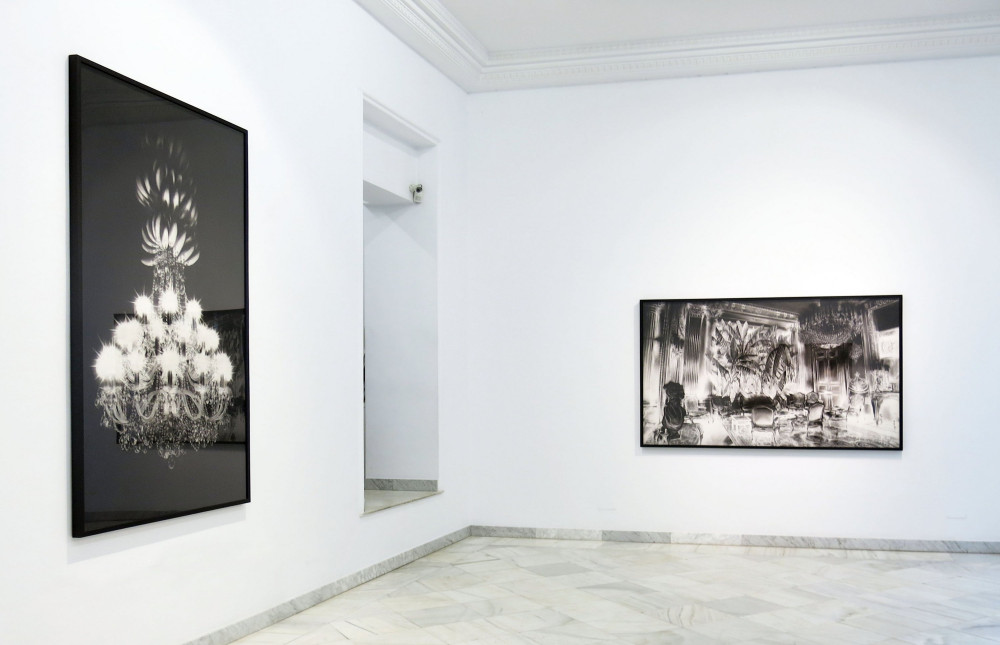
GONZÁLO FUENMAYOR. Tropicalypse
14 Nov - 14 Dec 2019
Fernando Pradilla Gallery opens the exhibition Inventory of Tears, the first solo exhibition in Madrid by Colombian artist Gonzalo Fuenmayor (Barranquilla, 1977). The show brings together a series of drawings made in the classic technique of charcoal on paper, which in the manner of European masters, relies in chiaroscuro as a way to seek light from darkness. Out of these dark backgrounds, worked intensively with charcoal, Fuenmayor brings out highlights which draw and illuminate the motifs of his works. The artist thus eliminates the use of color usually associated with the tropics and adopts black and white as a way of defining his hybrid identity.
The title of the exhibition arises, according to Fuenmayor, from a project carried out a few years ago “where Victorian chandeliers hung in the middle of a banana plantation”, encountering “the task of making an inventory of tears or crystals that hung from the chandeliers, in order to account for the pieces and avoid any loss. Opulence and decay filtered by the accuracy of an inventory”. Many of these chandeliers inhabit much of Fuenmayor's artistic production, playing a double function; on the one hand, illuminate in a literal and metaphorical sense, all what lies hidden by the shadows of reason, and on the other, to expose the symbol of maximum European luxury and decadence. The result of this opulence produces seemingly useless objects that, beyond their decorative function, become symbols of power.
The tears alluded in the title of the show are referenced in two large scale drawings. In "Collision", numerous fragments of these lamps are violently thrusted outwards after the clash between a palm tree and a chandelier, while in "Apocalypse XXV" the same tearsremain motionless hanging from a banana bunch. The tropics and the baroque are intertwined and entangled, alluding to recurrent negotiations implicit in the pursuit of an identity and the constant search for a sense of belonging. Precisely part of this quest is explored in the video "Pangea", also present in the exhibition, where anthems of North and South American nations reverberate at the same time, offering a deafening reflection about the unfulfilled promises of nationality.
Gonzalo Fuenmayor's speech is thus formed from irony and parody. The artist fuses objects with no apparent relationship and creates images that he defines as “visual grafts” where the contrast between the shape and its signifier takes on a new thought provoking reading on the spectator.
The exhibition includes two other series of drawings: "Over a Billion Served", inspired by Macondo and the mac-donalization of Latin American culture through clichés/propagandas, and "The End", which derives from the final credits of vintage Black and white movies. While the Macondo series exploits the iconic image through repetition and gestural variations, in "The End" series, each drawing represents a fictional final scene of an imaginary film. Despite both series convey different themes, they do share an interest in repetition and seriality, as well as a harmonious choreography of erasing and adding charcoal, of the baroque and the exotic, and surprise and expectation. The apocalyptic tone of the series, aims to propose unusual tensions between the text and picturesque postcards associated with a tropical paraphernalia. This look towards the tropics -the Caribbean-, finds a space for reflection concerning the hybridization between McDonald’s and Macondo, making visible the colonial exoticism towards Latin culture and its supposed magical realism.
Gonzalo Fuenmayor's work reflects the double cultural influence that has marked his artistic practice: Hispanic and American. His childhood and youth were spent in one of the cities that more fully embodies the essence of the Caribbean city (Barranquilla) and his professional activity has developed in the United States, where he lives and works today. His artistic research questions the Caribbean identity as a brand and the stereotypes that this concept has generated through images that have become local symbols such as the toucan bird, pineapples, palm trees and, especially, bananas. The latter has symbolized as no other fruit the paradox of abundance and poverty, being both food for the population and the cause of exploitation of the peasantry in the plantations in what has been called the "banana drama”.
His oeuvre, influenced by various sources, is a reflection on the identity and socio-political conditions of developing countries such as Colombia. The artist seeks to combine in his works a narrative line where the decorative and the tragic come together in a speech that borrows resources from literature, film and advertising.
Gonzalo Fuenmayor holds a Master's Degree in Visual Arts from the Boston School of the Museum of Fine Arts in affiliation with Tufts University of Somerville (Medford, Massachusetts, United States). Since 2000 he has obtained several scholarships and made several artistic residences, among which are the scholarship granted by the Keith Haring Foundation, New York (2000); the Art-Omi Artistic Residence in Ghent, New York (2006 ); the Vermont Studio Center Artistic Residence in Johnson, Vermont (2007); the Artistic Creation Scholarship awarded by the School of the Museum of Fine Arts in Boston (2012); La Sierra Artistic Residence in Santa Marta, Colombia (2017) and more recently the Harpo Foundation Grant in Los Angeles, California (2018) and the Art Center South Florida Studio Residency, Miami Beach, Florida (2018). His work has been exhibited in public and private institutions in the cities of Boston, San Francisco, Miami, New York, Bogotá, Barranquilla, Buenos Aires and Madrid. He’s also taken part in group shows at the EVA International Biennial of Visual Art, Limerick, Ireland (2018); the Frost Museum of Art, Miami, Florida (2018); the Centre d'art contemporain
































